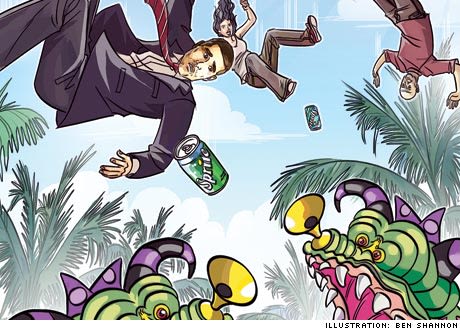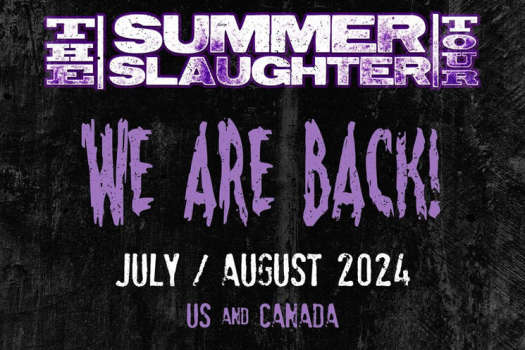During the run-up to last Mays season finale of the flashback-happy sci-fi serial Lost, one of the many corporations airing commercials on ABCs cult smash was the Hanso Foundation.
For longtime Lost fans this was pretty frackin rad. After all, the Foundation and its mysterious boss, Alvar Hanso, are at the root of all the fictional islands strange shenanigans from polar bears and that pilot-munching monster to the child-stealing Others and those disco-era Dharma Initiative hatches.
The commercials voiceover intoned: "Since the dawn of time, man has been curious, imagining all that is possible. The Hanso Foundation: reaching out to a better tomorrow. Discover the experience for yourself. Call 877-HANSORG.
If the intrigued were able to get past the busy signal, they came across several obscure Lost-related references (Widmore Corp., Geronimo Jackson) before their touch-tone navigation led to a warning from Persephone, an anti-Hanso activist who had hacked in to leave the password "breaking strain to get into protected areas of the Hanso Foundation website. The Lost Experience was off and running.
This intricate and interactive alternate reality game (ARG) is about blurring the line between fiction and reality. But its also a bold exercise in viral marketing for a medium desperately in need of a new business model now that so many DVR-owning viewers fast-forward through advertisements. Its no coincidence the games first clue came in the middle of a commercial break.
As if Lost wasnt already confusing enough, The Lost Experiences parallel storyline greatly expands the shows mythology by adding ever more hints, clues and peripheral characters.
About now you may be wondering what the heck an ARG is. Well, remember the 1997 David Fincher movie The Game? ARGs essentially follow the same model. These highly-immersive mixed media games combine the virtual and real with thousands of players around the world collaborating to solve mysteries via clues dug up on chat boards, websites, newspaper ads, film trailers, email, voicemail, pay phones, txt messages, MP3s, video files and blogs.
ABC further upped the meta when Hansos fictional communications director, Hugh McIntyre, appeared on the real Jimmy Kimmel Show to defend his company from its unflattering portrayal on Lost.
They raised those stakes again by publishing the clue-embedded bestseller Bad Twin by Gary Troup, an author who died in the Oceanic 815 plane crash that launched Lost he was the dude who got sucked into the planes still-spinning turbine in the first episode, and island bad boy Sawyer was later seen reading his Bad Twin manuscript.
Of course, Troup was an alias the ghost writer turned out to be thriller novelist Laurence Shames but the fact his pseudonym was an anagram of "purgatory got that first season theory back up and running (pointlessly, since the real clue appears to be Troups out-of-print book The Valenzetti Equation, about a mathematicians attempt to predict the apocalypse).
Anyway, the ensuing weeks revealed numerous other passwords, press releases, websites, and blog postings and well as audio and video, some of which connected to the real world in a manner that turned off many players.
A clue led to www.subLYMONal.com, which was a Sprite site (and subtly instructed us to "obey our thirst). Other game-related sites were sponsored by Jeep, Verizon and Monster.com, while interviews with Troup were posted on Amazon, Borders and Barnes & Noble.
What seemed like a cool time-killer or as ABC described it: "a giant, worldwide, mysterious jigsaw puzzle turned out to be a sneaky way to make us watch ads.
But experienced ARGers werent surprised by this. Though some smaller games are independently run, the professional ones usually have a commercial tie-in. The first major ARG was The Beast, a viral ad campaign run by Microsoft for the futuristic Spielberg film A.I.
The driving force behind the game was scripter Sean Stewart, an award-winning sci-fi novelist who described it as a "scavenger-hunt/soap opera. He wound up setting many of the genre standards, most importantly the mantra "this is not a game, which meant that at no point would anyone involved break the illusion of reality.
Stewart treated this new method of storytelling a fractured, non-linear narrative that players had to put back together cooperatively as a new art form. In 2004, Stewart penned the breakthrough ARG I Love Bees (aka "The Haunted Apiary), itself a prequel to the Xbox videogame Halo 2 and won an innovation award at the 2005 Game Developers Choice Awards.
Last year, Audi sponsored The Art of the Heist which incorporated real-world events, including one at the Coachella Music Festival and more recently, a crop circle-related game known as Who is Benjamin Stove? came to a conclusion after four months. Though players suspected there was a corporate sponsor behind the curtain, it was only revealed at the end to be part of General Motors pro-ethanol "Live Green, Go Yellow campaign when the missing Stove emerged to post an online manifesto calling on the world to stop using fossil fuels. Its unknown if this slyer advertising technique actually works, but GM seems happy with the 1.8 million page views the game garnered during its run.
So far the biggest non-corporate ARG ever is Adrian Hons Perplex City (he actually quit his Oxford PhD program to be the games "PuppetMaster), a sci-fi game involving a stolen "Receda Cube, 20,000 gamers and over a years worth of storyline so far. While most ARGs are funded by ad campaigns, Perplex requires participants to purchase sets of puzzle cards to gather clues though theyre also offering a $200,000 U.S. reward to the eventual case-cracker and its success may steer this emerging genre towards independence from marketing mavens.
But in the meantime, Lost gets to maintain momentum during the off-season, deepen its back-story and cleverly involve the fanboys and girls who gripe about the writers miserly doling of information. The embedded advertising is certainly an annoyance, but thats the cost of playing for free.
For longtime Lost fans this was pretty frackin rad. After all, the Foundation and its mysterious boss, Alvar Hanso, are at the root of all the fictional islands strange shenanigans from polar bears and that pilot-munching monster to the child-stealing Others and those disco-era Dharma Initiative hatches.
The commercials voiceover intoned: "Since the dawn of time, man has been curious, imagining all that is possible. The Hanso Foundation: reaching out to a better tomorrow. Discover the experience for yourself. Call 877-HANSORG.
If the intrigued were able to get past the busy signal, they came across several obscure Lost-related references (Widmore Corp., Geronimo Jackson) before their touch-tone navigation led to a warning from Persephone, an anti-Hanso activist who had hacked in to leave the password "breaking strain to get into protected areas of the Hanso Foundation website. The Lost Experience was off and running.
This intricate and interactive alternate reality game (ARG) is about blurring the line between fiction and reality. But its also a bold exercise in viral marketing for a medium desperately in need of a new business model now that so many DVR-owning viewers fast-forward through advertisements. Its no coincidence the games first clue came in the middle of a commercial break.
As if Lost wasnt already confusing enough, The Lost Experiences parallel storyline greatly expands the shows mythology by adding ever more hints, clues and peripheral characters.
About now you may be wondering what the heck an ARG is. Well, remember the 1997 David Fincher movie The Game? ARGs essentially follow the same model. These highly-immersive mixed media games combine the virtual and real with thousands of players around the world collaborating to solve mysteries via clues dug up on chat boards, websites, newspaper ads, film trailers, email, voicemail, pay phones, txt messages, MP3s, video files and blogs.
ABC further upped the meta when Hansos fictional communications director, Hugh McIntyre, appeared on the real Jimmy Kimmel Show to defend his company from its unflattering portrayal on Lost.
They raised those stakes again by publishing the clue-embedded bestseller Bad Twin by Gary Troup, an author who died in the Oceanic 815 plane crash that launched Lost he was the dude who got sucked into the planes still-spinning turbine in the first episode, and island bad boy Sawyer was later seen reading his Bad Twin manuscript.
Of course, Troup was an alias the ghost writer turned out to be thriller novelist Laurence Shames but the fact his pseudonym was an anagram of "purgatory got that first season theory back up and running (pointlessly, since the real clue appears to be Troups out-of-print book The Valenzetti Equation, about a mathematicians attempt to predict the apocalypse).
Anyway, the ensuing weeks revealed numerous other passwords, press releases, websites, and blog postings and well as audio and video, some of which connected to the real world in a manner that turned off many players.
A clue led to www.subLYMONal.com, which was a Sprite site (and subtly instructed us to "obey our thirst). Other game-related sites were sponsored by Jeep, Verizon and Monster.com, while interviews with Troup were posted on Amazon, Borders and Barnes & Noble.
What seemed like a cool time-killer or as ABC described it: "a giant, worldwide, mysterious jigsaw puzzle turned out to be a sneaky way to make us watch ads.
But experienced ARGers werent surprised by this. Though some smaller games are independently run, the professional ones usually have a commercial tie-in. The first major ARG was The Beast, a viral ad campaign run by Microsoft for the futuristic Spielberg film A.I.
The driving force behind the game was scripter Sean Stewart, an award-winning sci-fi novelist who described it as a "scavenger-hunt/soap opera. He wound up setting many of the genre standards, most importantly the mantra "this is not a game, which meant that at no point would anyone involved break the illusion of reality.
Stewart treated this new method of storytelling a fractured, non-linear narrative that players had to put back together cooperatively as a new art form. In 2004, Stewart penned the breakthrough ARG I Love Bees (aka "The Haunted Apiary), itself a prequel to the Xbox videogame Halo 2 and won an innovation award at the 2005 Game Developers Choice Awards.
Last year, Audi sponsored The Art of the Heist which incorporated real-world events, including one at the Coachella Music Festival and more recently, a crop circle-related game known as Who is Benjamin Stove? came to a conclusion after four months. Though players suspected there was a corporate sponsor behind the curtain, it was only revealed at the end to be part of General Motors pro-ethanol "Live Green, Go Yellow campaign when the missing Stove emerged to post an online manifesto calling on the world to stop using fossil fuels. Its unknown if this slyer advertising technique actually works, but GM seems happy with the 1.8 million page views the game garnered during its run.
So far the biggest non-corporate ARG ever is Adrian Hons Perplex City (he actually quit his Oxford PhD program to be the games "PuppetMaster), a sci-fi game involving a stolen "Receda Cube, 20,000 gamers and over a years worth of storyline so far. While most ARGs are funded by ad campaigns, Perplex requires participants to purchase sets of puzzle cards to gather clues though theyre also offering a $200,000 U.S. reward to the eventual case-cracker and its success may steer this emerging genre towards independence from marketing mavens.
But in the meantime, Lost gets to maintain momentum during the off-season, deepen its back-story and cleverly involve the fanboys and girls who gripe about the writers miserly doling of information. The embedded advertising is certainly an annoyance, but thats the cost of playing for free.




